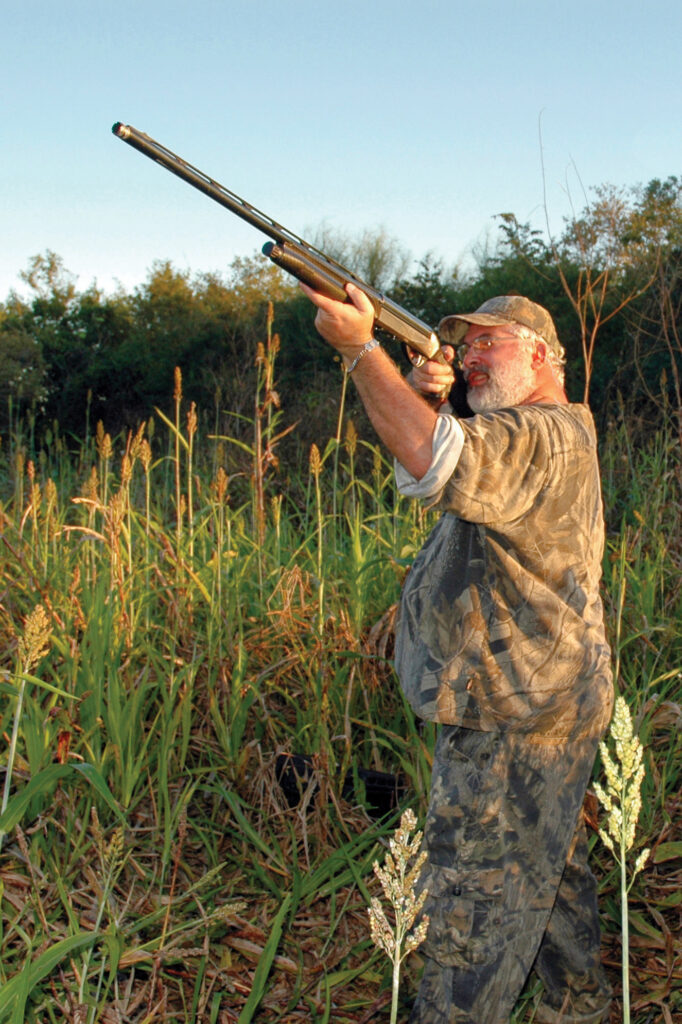The small creek barely trickling with water nourished thick brush and cane growing on both sides of the little stream.
I slowly moved along a path through the pine savanna, listening and watching. The narrow path led to a break in the green vegetative wall at the creek. As I approached the break, the creek bed erupted with the distinctive whistling clatter made by long, elegant elliptical wings of a magnificent game bird. Any bird hunter would instantly recognize that sound as mourning doves scattered in all directions.
Most dove hunters stand in a tree line, at the edge of a field or sit in a chair surrounded by high weeds watching for doves to fly into range. Rather than wait for the swift and majestic birds to visit me, I like to go to their lair and roust them.
Almost like quail hunting, but without dogs alerting sportsmen to coveys, hunters walk where birds might hide. Stay alert when approaching good cover. At any second, flushing birds could generate adrenaline-pumping excitement, sometimes almost under the feet of hunters.

To jump doves, sportsmen must first find them. Doves like open fields or semi-open grassy savannas punctuated by scattered trees, brush or fencerows. Sportsmen can walk slowly along forest edges, powerlines, fire breaks, food plots and other openings or through scattered timber.
Doves require four main ingredients to survive – food, cover, water and grit. Locate those things to find where the birds want to stay. The small birds usually pick seeds off bare dirt but want leafy canopy cover above them so they can hide from hawks and other predators.
“A dove’s diet consists of about 99 percent seeds,” says Seth Maddox, assistant chief of the Wildlife Section for the Alabama Division of Wildlife & Freshwater Fisheries. “They will eat any type of cultivated grain such as corn, millet, sorghum, also called milo, even peanuts. They also go for native vegetation, such as grass seeds, herbs and weed seeds. Occasionally, doves eat berries or maybe even something like snails for calcium. They also need a good amount of water every day.”
Doves normally feed at first light. To digest rough seeds, doves need water and grit. They swallow small pieces of gravel or sand to break up the seeds. Sportsmen frequently find them “dusting” or picking up bits of rock around grit piles or sandy patches.
For water, the diminutive birds don’t require Lake Guntersville. Just a puddle in a tire rut on a gravel or dirt trail could suffice. Doves commonly stay around streams, creek beds or ponds. A gravelly sandbar with scrubby brush growing along a stream or pond shoreline near croplands could provide an excellent place to jump doves.
After filling their bellies, doves look for a place to rest and digest. While “nooning,” they usually perch in tall trees, electrical wires, or other places that give them a good vantage point for spotting danger. They might stay in their nooning area for a while unless something disturbs them.
In the afternoon, doves get hungry again and return to their feeding fields. They might also hit the grit piles and waterholes. When jumping doves, sportsmen could spot some lookouts perched in high places looking for predators. While these birds watch for danger, several others could already forage on the ground. Find some good cover to stalk them.
Often, hunters can work in teams. On powerlines, one person could walk on one side while another walks along the other side. At fencerows or tree lines, sportsmen can walk on both sides to catch birds flushing from any direction. Pay attention to where other hunters stand and watch the shots.
Walking up on doves could put birds in the bag with considerable excitement. Swift and erratic fliers, mourning doves can exceed 55 miles per hour with twisting flight patterns that make them extremely challenging aerial targets. I recommend high-power 7 1/2 shot with an improved cylinder choke to bring them down.
In the North Zone, the Alabama dove season opens at noon on Sept. 7 and runs through Oct. 20. The South Zone opens at noon Sept. 14 and continues through Oct. 27. The second split in both zones lasts from Nov. 23 through Dec. 1. The late split runs from Dec. 14 to Jan. 19, 2025. Sportsmen may bag up to 15 birds per day in any combination of mourning and white-winged doves.
For more information on hunting doves, see outdooralabama.com/hunting/seasons-and-bag-limits.
John N. Felsher is a professional freelance writer who lives in Semmes, Ala. He also hosts an outdoors tips show for WAVH FM Talk 106.5 radio station in Mobile, Ala. Contact him at [email protected] or through Facebook.




